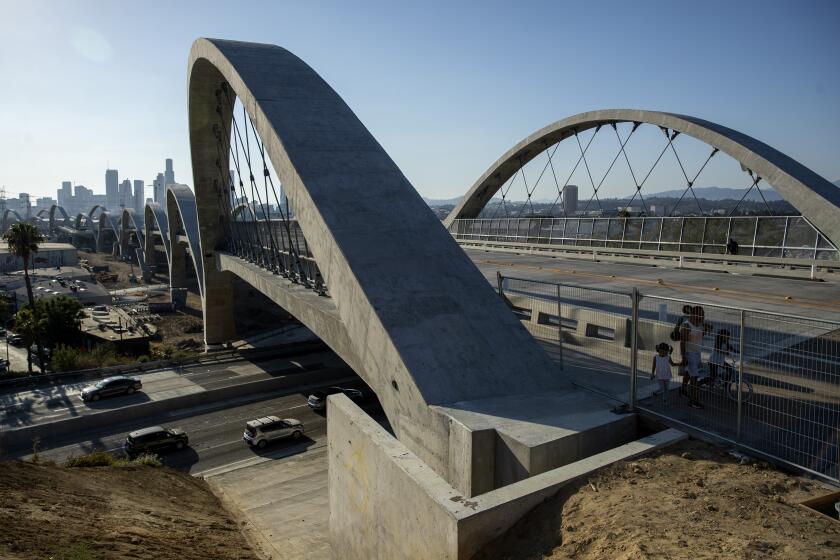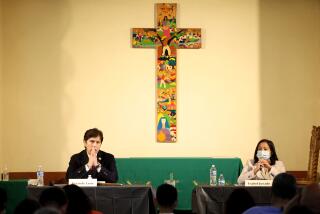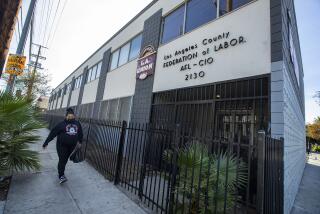How hard should L.A. go after copper wire thieves? Council members hold a lively debate

A member of a historic church in South Los Angeles pointed out to Councilmember Marqueece Harris-Dawson on Sunday that a landmark item was missing from the building: a bronze plaque.
The plaque at Bethel A.M.E Church had withstood the Great Depression, segregation and other economic downturns, only to disappear a couple of weeks ago, Harris-Dawson said. The plaque may have been stolen amid a surge of copper wire and bronze thefts across the city.
“I do think we have a mutation of petty theft that we need to look at in a serious and deep way,” said Harris-Dawson, whose district has also seen “stretches” of streets targeted by thieves.
The anecdote was shared at the end of a nearly one-hour debate Wednesday — in which more than half of the City Council spoke — over whether to approve motions by Councilmembers Kevin de León and Traci Park to curb copper wire theft. Beyond wire theft, the invigorating conversation illuminated the council members’ differing approaches to crime, with some wishing for more preventive efforts and others pushing for accountability.
Among growing concern over copper wire thefts, L.A. City Councilmembers Kevin de León and Traci Park proposed a task force anchored by the LAPD.
The motions, which passed on a 13-2 vote, will create a task force with the Los Angeles Police Department and the Bureau of Street Lighting and establish a rewards program to encourage the public to submit information regarding the thefts.
Councilmember Eunisses Hernandez said the rewards program “misses critical steps in understanding the root of this problem.”
“Rather than expand city efforts and resources on a reward program that does not intervene until after the damage is done and focuses on punitive measures, why aren’t we looking into how we can prevent this cycle together?” said Hernandez, who voted no on the motions.
Hernandez praised a Jan. 9 motion by Councilmember Heather Hutt that requested an examination of replacing copper wires with solar-powered lighting. Efforts like those, Hernandez said, address the root causes of the problem instead of spending money on “solutions that are Band-Aids.” (Hutt did not speak during Wednesday’s discussion but voted to approve both motions.)
Councilmember Monica Rodriguez stood by the rewards program, noting that accountability was necessary to prevent further expense to taxpayers.
“We can’t make it easier for them to continue to break into these systems, steal the copper wire, cash it in and create a bigger public safety threat,” Rodriguez said of the thieves.
Council President Paul Krekorian redirected the council’s attention to the “unscrupulous purchasers of stolen metal,” who he said were the “real source” of the problem.
Since November, Krekorian and City Atty. Hydee Feldstein Soto have been targeting those who receive the stolen metal. He said the way to prevent the crime was to make it no longer profitable.
From within his district, Harbor-area Councilmember Tim McOsker lamented the loss of plaques at the American Merchant Marine Veterans Memorial as well as at other memorials dedicated to fishing industry families and longshore workers.
McOsker noted that the Los Angeles Port Police had arrested three people — Dionzay Tisby, 42, Brittany Draper, 37, and Deona Jackson, 28 — on suspicion of grand theft related to the plaque thefts.
Councilmember Hugo Soto-Martínez joined Hernandez in opposing the motions, even though he had initially supported the idea. He asked his colleagues to understand that the thefts might be committed by people living in poverty who are pushed into acts of desperation.
Soto-Martínez urged the council to be “smart legislators” and pursue prevention efforts.
Get the lowdown on L.A. politics
Sign up for our L.A. City Hall newsletter to get weekly insights, scoops and analysis.
You may occasionally receive promotional content from the Los Angeles Times.
“It’s not just about getting rewards and criminalizing, and I get that’s probably part of the solution. But at the end of the day, it’s not going to solve the issue,” Soto-Martínez said.
In response, Councilmember Imelda Padilla acknowledged Soto-Martínez’s point about poverty but disagreed that the responsible individuals were “impoverished criminals.”
“This is really high, sophisticated, smart, clever, organized crime,” she said.
Councilmember John Lee also pushed back against Soto-Martínez, noting that the funds he wishes he could spend on youth centers or community programs are instead going to costly measures to deter thieves.
“We focus on the person committing the crime and not the victim anymore,” he said. “I don’t understand why we should not be looking at every single thing at our disposal.”
De León said he appreciated the range of perspectives on the issue but clarified that the motions were meant to give priority to public safety and speak to the concerns of residents.
In late December, thieves stole a third of the 6th Street Viduct’s copper wires. De León, whose district includes the structure, said the individuals could receive a “street value” of $11,000 for the stolen material. But repairs will cost taxpayers $2.5 million.
“This is not criminalizing this act,” De León said, “because it’s already a crime.”
More to Read
Sign up for Essential California
The most important California stories and recommendations in your inbox every morning.
You may occasionally receive promotional content from the Los Angeles Times.












